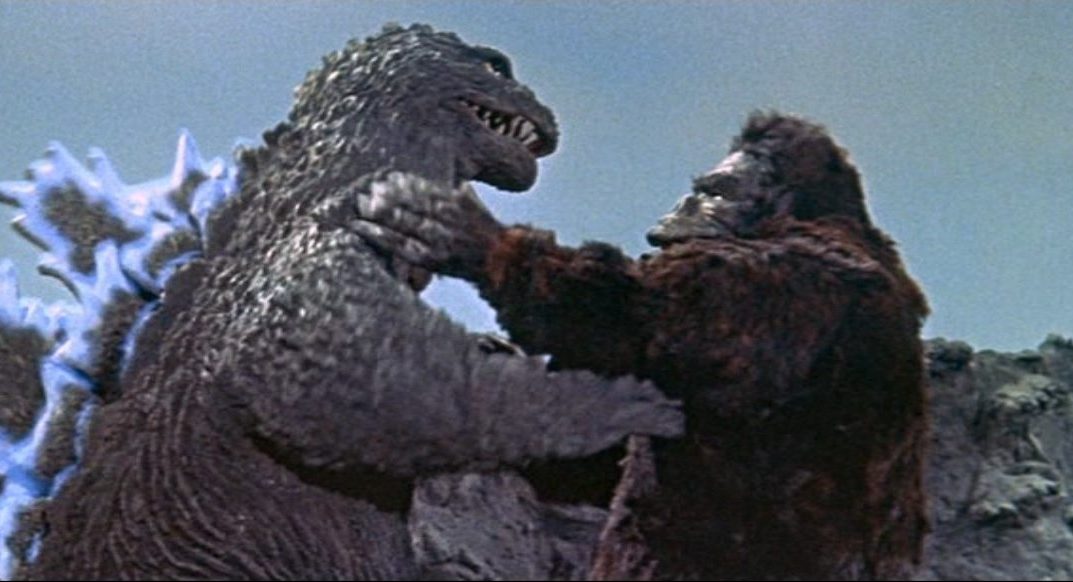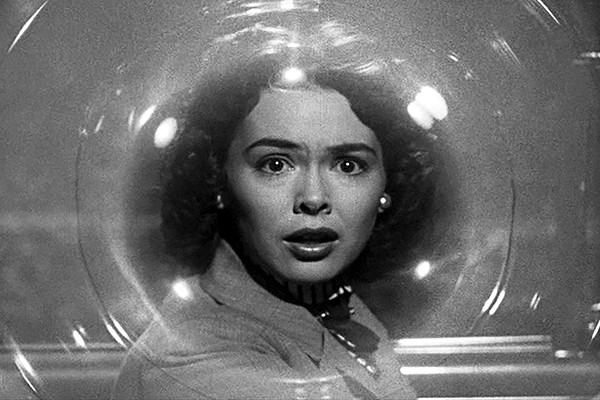With the arrival of Godzilla vs. Kong in theaters and streaming, I sat down to revisit the classic 1962 film King Kong vs. Godzilla with someone who has never seen it. Mason Barton is nine years old — the prime target audience for kaiju films. He reviews movies in his new podcast with Stephen Hildreth, a filmmaker who partners with Mason’s father Chad Allen Barton in the Memphis production company Piano Man Pictures. I edited our conversation for length and clarity.
Chris McCoy: It’s been a really long time since I’ve seen this movie.
Stephen Hildreth: I have never seen this movie.
Mason Barton: GO KONG!
CM: You’re rooting for Kong. What do you know about this movie?
MB: Absolutely nothing.
CM: Stephen, what about you?
SH: I know nothing about this movie.
MB: King Kong and Godzilla are going to fight, and they’re most likely going to end up fighting something else, because they would never say who would win or who would lose.
97 minutes later…
CM: OK! Mason and Stephen, you are now people who have seen King Kong vs. Godzilla. What did you think?
MB: It was great! I liked the stuff that didn’t make sense. It was funny, weird, and had really good fight scenes.
CM: The fight scenes were outstanding.
SH: They were really great.
CM: Some of the best in any Godzilla movie, I think. And they used everything! They had guys in suits, they did some stop motion. At one point, it was just a couple of hand puppets going at it. And the octopus! That was a real, live octopus, wasn’t it?
SH: Yeah, that was impressive. All of the practical effects were kind of amazing, like the entire sequence with Kong, where it’s rear projection, and we’re looking through the train car. Cut around to the reverse, where they have the little doll for him to carry, to look like the woman. That was all brilliant. I loved the real, live octopus.
MB: Wait, what?
SH: The octopus that attacks Kong on the island was a real, live octopus.
MB: Is it that big?
SH: No, they just shot it to look big. They’re pretty big, but not that big.
MB: I have a question. The balloons they used to carry Kong—why were they yellow?
SH: I think those were weather balloons.
CM: So, Mason. You were rooting for King Kong. Do you think Kong won?
MB: Oh yes. He beat up Godzilla so hard, Godzilla just straight up left.
CM: That’s true. But there was that earthquake there at the end, so we don’t really know what happened while they were fighting underwater. I feel like if there hadn’t been that convenient electrical storm, Kong wouldn’t have won. He got re-energized. But since when does Kong get power from electricity? He’s like, Electro-Kong.
SH: WWE owes a lot to movies like this. It’s scripted like a wrestling match. Hulk Hogan totally stole his honk-it-up move from Godzilla. Watching this, I’m convinced. There’s a lot of little contrivances, but I’m willing to accept it to see two giant monsters fight one another.
CM: You’d think they could unite in their love of property damage. At the end, when they’re fighting over that giant pagoda, both of them were just like, “Yeah, let’s just smash this pagoda, then get back to fighting.”
SH: That reminded me of one of those bonus rounds of Street Fighter where you get points for just smashing the car.

CM: Mason, why were you for Kong?
MB: Because I think he’s just cooler. And it’s a little bit unfair. Godzilla’s got like, five powers. And King Kong still just came around and beat the crap out of him.
CM: Stephen, what was your rooting interest?
SH: I was rooting for property damage.
CM: We’re all winners.
SH: There was a part at the beginning where I thought they were teasing that they would both be fighting Mechagodzilla. Maybe that was something they were teasing for the new one?
MB: I thought that the entire time, too.
SH: Like it was going to be, oh no, this is not really Godzilla. It’s evil Mechagodzilla.
CM: No, this was 1962. Mechagodzilla didn’t come along until about 1973. Terror of Mechagodzilla, in 1974, was Ishiro Honda’s last Godzilla film. It’s actually really good. All the Ishiro Honda films are. I mean, you could tell which parts were the Japanese parts and which parts were the American parts, couldn’t you?
MB: Yeah.
CM: The American parts were just three white guys standing in front of a sheet. But Ishiro Honda was a genius. He was also Akira Kirosawa’s favorite assistant director. He went from Terror of Mechagodzilla to Kagemusha and Ran.
SH: There are some really nice compositions in this.
CM: It’s gorgeous!
SH: And the matte paintings! Especially on the island, when they get there. We just reviewed the first Coming to America for our little thing. That was the one knock that I really had for Craig [Brewer]’s version. When you get to Zamunda in the second one, the palace doesn’t feel as epic as it does in the first one, Maybe it’s because it’s CG. Really, the palace, it’s not that big on the set. It’s just a matte painting beyond that, but I’m a sucker for a good matte painting. Cause they’re just gorgeous and they look fantastic. The ones in this were all incredible.
CM: All of the special effects were just perfectly executed. There’s just something about the guy in the Godzilla suit, stomping on little miniature buildings, you know?
SH: When he falls into the hole, after they have that whole blast setup to trap him, it has such a human quality, even though it’s this giant monster falling into hole. ‘Cause it is just a guy in a suit. Maybe it’s something like that that makes me identify with Godzilla. His face is a little inviting to me. Kong’s is kind of horrifying, a little bit…
MB: A little weird.
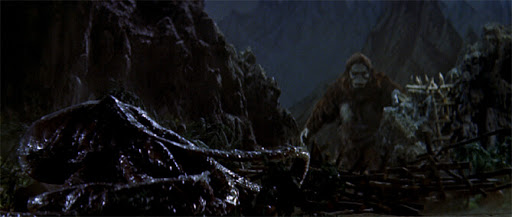
CM: Have you seen the original King Kong?
MB: I tried to watch it for a little bit, but I couldn’t get into it.
SH: Black and white? Stop motion animation?
MB: Yeah.
CM: Do you not like black and white?
MB: No, there’s been one or two I’ve seen that I liked.
CM: What don’t you like about them?
MB: Usually, they’re so old, the sound is real bad. It’s not like I don’t like the black and white photography, as long as the sound quality is good.
CM: I get that. They perfected shooting in black and white long before they perfected sound. So you’ve never seen any Godzilla movies?
MB: None. The only thing I’ve ever seen close to this stuff is Kong: Skull Island.
CM: Well, you were the target audience for this in 1962. As time went on, they got a lot weirder. Three years later was Invasion of Astro Monster, which is probably my favorite. It’s got goofy aliens in UFOs, and I just love it. But at some point, you should go back to Ishiro Honda’s original Japanese version, Gojira. Have you ever watched a film with subtitles before?
MB: Yes, and I do not like it.
CM: Well, if you feel like trying it, the original Godzilla is an entirely different vibe. It’s genuinely scary. So, are you going to see Godzilla vs. Kong?
MB: Yes! I’ve already put a bet on it.
CM: You got your money on Kong for that one, too?
MB: Yes, but what I’m also thinking that they’re just going to team up and fight somebody else. And then that means that the person I bet with, we’re both going to get $15.
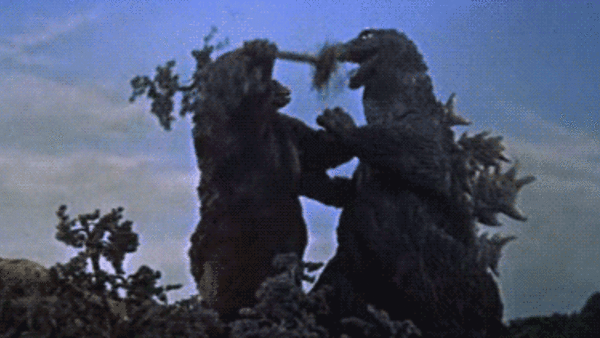
CM: Did you feel like Godzilla was the bad guy in this movie?
MB: Yes.
CM: And what about Kong? Did he feel like a bad guy?
MB: Not really.
CM: Kong is always sympathetic, because he was just minding his own business, and people come and Kong-nap him from his island. And whose bright idea is it to take the giant ape into the middle of New York City, anyways? Hey, let’s put him on Broadway! It’s just stupid. Carl Denham is the real villain of King Kong.
CM: I thought one thing was interesting. If you watch King Kong now, when they’re on Skull Island at the beginning, the racist caricature of the natives is really obvious. I can totally see a Black person watching this and saying, I’m not finishing it. You kind of have to divorce the special effects masterpiece part of it from that part. But in this film, they felt like they had to do the Kong origin story again. So they felt like they had to go and do that part again, too. But it’s Japanese people trying to do it. So maybe it’s not as racist, or it’s racist in a weird way I don’t even understand.

SH: They’re still doing like, a form of brown face with those characters, but they’re Japanese people doing it.
CM: Some of those people were just different flavors of Asian, with darker skin, without much makeup. But some of them were obviously people who were painted up. And what’s even weirder is, it felt like a critique of colonialism, almost. Here were these guys in pith helmets giving cigarettes to the native children. Classic colonialist move. Those guys looked like buffoons. But when they were making the American cut, they were like, leave that stuff in there! Americans can relate to that! Those English punch-ins, they probably cost like $200 total. It was two white guys in front of a curtain explaining what happened.
SH: Yeah. It seemed like there were a lot of news reports in this.
CM: They’re not in the original. It’s more of a traditional …
SH: … flowing story.
CM: I guess the American producers thought there needed to be a play-by-play and color commentary on this thing.
SH: I wanted the United Nations Wide World of Sports, where Howard Cosell calls the fight between King Kong and Godzilla. That was the one thing that I was aching for at the end of the film. You get a little bit of that from the guys in the helicopter.
CM: I was just rooting for all the humans to die.
SH: They’re the real villains. Kong is the reluctant hero. Godzilla, he was asleep and his home, and they just busted up into his place…
CM: … with atomic weapons. And now he’s all radioactive. Like Mason said, the atomic fire breath really gives Godzilla the advantage. He can just roast Kong from afar.
SH: That’s why in the new one, they give him an axe.
CM: Kong’s got an axe?
SH: A giant axe, and he blocks Godzilla’s fire breath with it.
CM: I mean, why not just give him a lightsaber?
SH: And a Captain America shield. Let’s just throw all the properties in there.
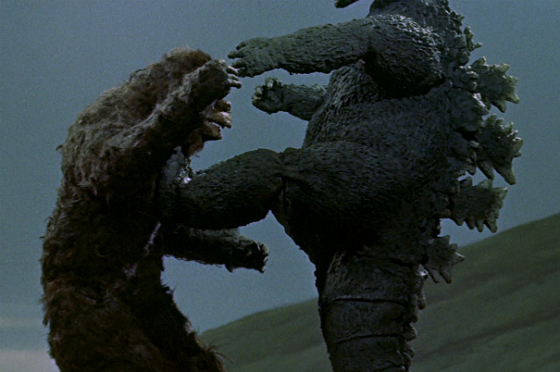
MB: I would say the best scene of the entire movie is when Godzilla kicked King Kong. That looked amazing.
CM: And the tail flip!
MB: That was good too!
CM: It’s fun to watch it and say,”That’s how they did it!” And it’s fun when you say, “I have no idea how they pulled that off.”
SH: Their trickery was amazing. That was a great thing to see. I’m really glad you asked us to do this.
CM: OK, final verdict, Mason, would you recommend other people watch King Kong vs. Godzilla?
MB: Yes, and you should watch it before you watch Godzilla vs. Kong.
